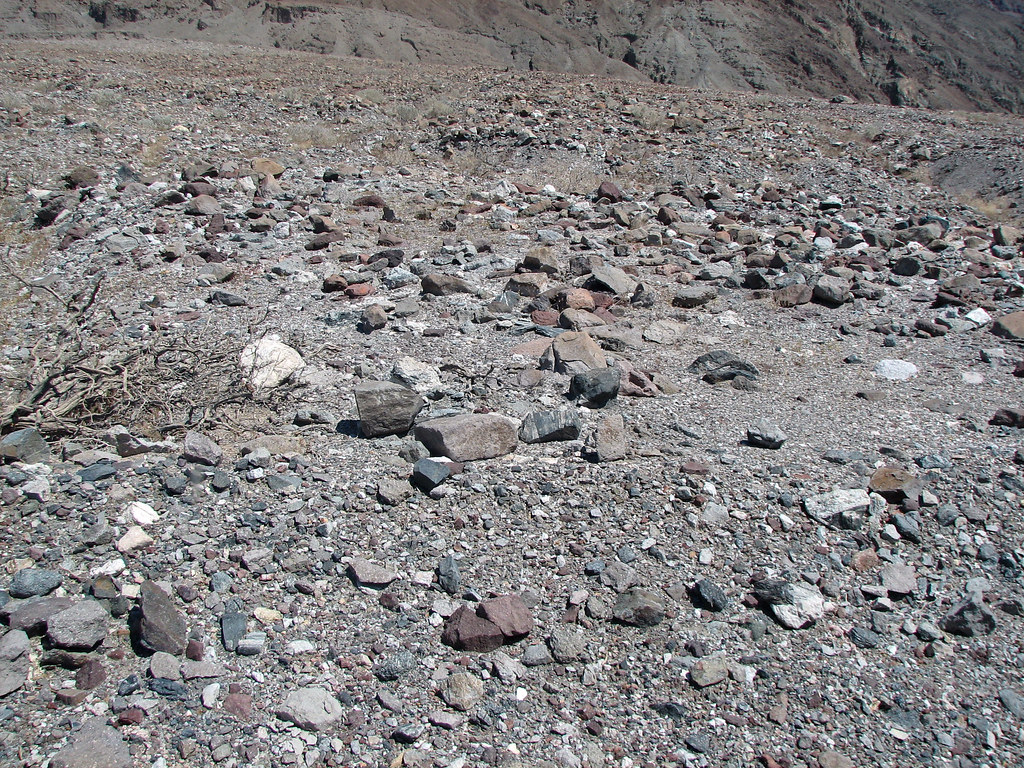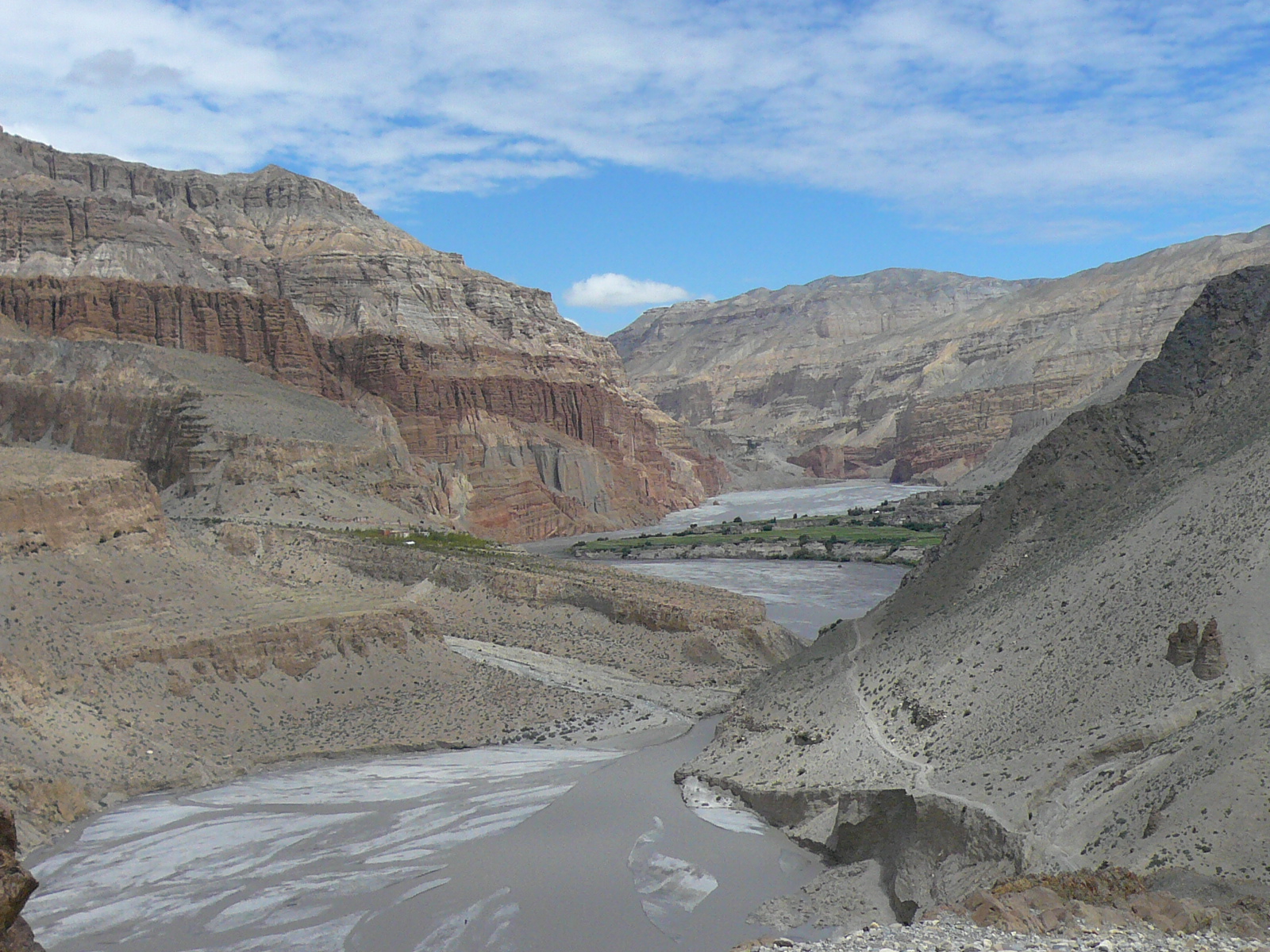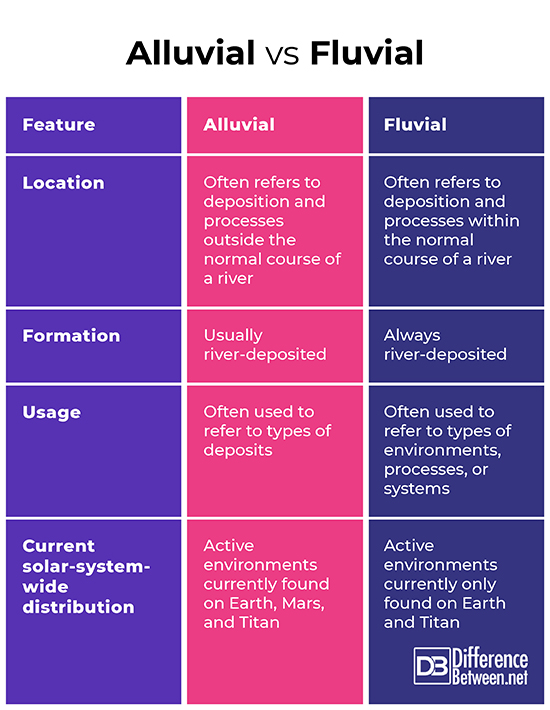Difference Between Alluvial and Fluvial

What is Alluvial?
The term alluvial is used to refer to sedimentary deposits consisting of a mixture of sand, clay, silt, and gravel that are typically formed by rivers. The sediment that makes up alluvial deposits is referred to as alluvium. The term alluvial is often used to describe sediments that are deposited beyond the normal flow path or banks of a river, such as floodplains and deltas.
There are many different landforms associated with alluvium which include alluvial fans, deltas, and floodplains, also called alluvial plains. Alluvial deposits are found on at least three solar system bodies, Earth, Mars, and Saturn’s moon Titan. These three planetary bodies all have surfaces that are shaped or have been shaped in the past by the movement of liquid. In the case of Earth and Mars, it is liquid water. In the case of Titan, it is liquid methane.
What is Alluvial fan?
Alluvial fans are cone-shaped structures that are formed as water carries sediment out of a narrow catchment into a broad plain or basin. The change in flow strictures causes the sediment to be deposited in a broad-fan shaped landform on the basin floor. Another feature of an alluvial fan is that there is a steep gradient between the catchment and the basin below. In arid regions, another process that drives the transport and deposition of this material is flooding.
Floods, caused by rain, drain out of narrow valleys into broader plains. The proximal alluvial material, that is, material close to the mouth of the narrow valley, will be coarser grained. Farther from the fan, where the slope drops off into the basin, only finer grained material is carried and deposited. This finer grained material includes sand, gravel, and clay. In hot areas, water will evaporate leaving behind minerals, such as halite and gypsum.
What is Delta?
A delta is an alluvial deposit or environment formed where a river drains into the ocean or another large body of water. Deltas are named because their roughly triangular shape resembles the Greek letter delta and it was the ancient Greeks who gave the delta its technical name.
Deltas consist of three sections, the upper delta plain, the lower delta plain, and the subaqueous delta. The upper delta plain starts where the river valley begins to widen as it meets the coastal plain. This point is called the apex. From the apex, the river separates into several smaller waterways. The upper delta plain typically has an abundance of fresh-water swamps and marshes. At this point, the environment is entirely controlled by riverine processes. The lower delta plain contains environments controlled by a mixture of coastal and riverine processes. It will have environments including mangrove swamps, saline flats, and beach fronts. The lower delta plain is also prone to flooding from the tidal zone.
The subaqueous delta is the sediment that accumulates underwater on the continental shelf. As the subaqueous delta builds up, the subaerial part of the delta gradually migrates farther out into the ocean, building upon the foundations of the subaqueous delta.
Floodplain
A floodplain consists of sedimentary deposits formed by a river moving laterally across a landscape and the river water periodically flooding its banks.

What is Fluvial?
Fluvial refers to processes and structures related to the flow of liquid across land surfaces in the form of rivers, water in the case of Earth and Mars, and liquid methane in the case of Titan. Fluvial is also used to refer to erosion and deposition related to the regular flow of liquid. Over time, the landscape on Earth is worn down by the flow of water as the water weakens rock, leading to erosion and transport of sediment. This leads to more erosion as the sediment is also essentially scraped against the terrain by the movement of the river. Eventually, rivers create the channels and valleys in which they exist.
Rivers often have their source in mountains and hills. As a result, the source region of a river often has steep slope gradients. For this reason, Rivers are fast flowing near their source and can carry larger sediment grains. As rivers flow out of hills and mountains and into valleys and basins, the gradient is reduced and the water in the river loses kinetic energy. As it loses kinetic energy, it begins to deposit the heavier particles it is carrying. For this reason, river sediment gets finer grained with greater distance from the source of the river. There may be cobbles, gravel or even boulders near the source and sand, clay and silt by the time the river reaches the delta.
Similarities between alluvial and fluvial
Alluvial and fluvial both refer to processes, sedimentary deposits, and landforms that were created by the movement of water.
Differences between alluvial and fluvial
Although there are similarities between what is considered fluvial and what is considered alluvial, there are also important differences. These differences include the following.
- Alluvial deposits consist of sediment that is deposited by rivers when the river water goes beyond its normal boundaries, or banks, such as floodplains or deltas, whereas fluvial usually refers to processes that occur within the normal course of the river under a regime of continuously flowing water.
- Alluvial deposits can also be caused by other processes, such as flash floods, whereas fluvial deposits are always created by rivers.
- Alluvial appears to be more often used to refer to types of deposits, whereas fluvial is used more often to refer to environments and systems.
- Alluvial deposits appear to be more common in the solar system, currently, since they occur on Earth, Mars, and Titan, whereas extant rivers likely only occur on Earth and Titan.
Alluvial vs. fluvial

Summary
Alluvial refers to geologic processes and formations that often result from river water going outside the bounds of the normal course of the river, or beyond its banks. Alluvial deposits consist mostly of mixtures of clay, silt, sand, and gravel. Common alluvial environments include floodplains, deltas, and alluvial fans. Fluvial refers to processes, systems, environments, and deposits that occur or form during the normal course of a river. Fluvial deposits become more fine-grained with increasing distance from the source of a river because the river gradually loses kinetic energy as it flows into regions with a lower slope gradient. Rivers play a large role in the formation of the valleys in which they flow. Alluvial and fluvial are similar terms in that they both refer to deposits created by moving water, usually in the form of rivers. They differ in that some alluvial deposits, such as alluvial fans, can be formed by processes besides rivers, such as flash floods, whereas fluvial deposits are always deposited by rivers. Also, typically fluvial refers to deposits and processes within the normal course of a river, whereas alluvial typically refers to deposits that were formed outside the normal course, or beyond the banks, of a river, such as during a flood or in a delta. Fluvial also seems to be used more often to refer to processes and environments, whereas alluvial is used more often to refer to specific landforms. Active alluvial environments also appear to be found more often than fluvial environments across the solar system.
- Difference Between Environmental Performance Index and Development - November 24, 2023
- Difference Between Environmental Intervention and Development - November 8, 2023
- Difference Between Eco Efficiency and Eco Effectiveness - September 18, 2023
Search DifferenceBetween.net :
Leave a Response
References :
[0]Gough, Evan. “Rivers on Mars Flowed for More Than a Billion Years.” Universe Today, 1 Apr. 2019, https://www.universetoday.com/141879/rivers-on-mars-flowed-for-more-than-a-billion-years/. Accessed 13 August 2020.
[1]Kite, Edwin S. "Geologic constraints on early Mars climate." Space Science Reviews 215.1 (2019): 10. https://link.springer.com/content/pdf/10.1007/s11214-018-0575-5.pdf
[2]Lu, Donna. “An ancient river on Mars may have flowed for 100,000 years.” New Scientist, 5 May 2020, https://www.newscientist.com/article/2242630-an-ancient-river-on-mars-may-have-flowed-for-100000-years/. Accessed 13 August 2020.
[3]Mone, Gregory. “Cassini Finds a New Nile River on Titan.” Discover, 11 Dec. 2013, https://www.discovermagazine.com/the-sciences/cassini-finds-a-new-nile-river-on-titan. Accessed 13 August 2020.
[4]Moore, Jeffrey M., and Alan D. Howard. "Large alluvial fans on Mars." Journal of Geophysical Research: Planets 110.E4 (2005). https://agupubs.onlinelibrary.wiley.com/doi/pdf/10.1029/2004JE002352
[5]Radebaugh, Jani, et al. "Alluvial and fluvial fans on Saturn's moon Titan reveal processes, materials and regional geology." Geological Society, London, Special Publications 440.1 (2018): 281-305.https://sp.lyellcollection.org/content/440/1/281
[6]Sumner, Dawn. Sediments and Strata. University of California Davis, Jun. 2019, https://geo.libretexts.org/Courses/University_of_California_Davis/UCD_GEL_109%3A_Sediments_and_Strata_(Sumner)/08%3A_Old_or_Lost_Pages/8.01%3A_Alluvial_Fans. Accessed 11 August 2020.
[7]The Editors of Encyclopaedia Britannica. “Alluvial deposit.” Encyclopaedia Britannica, Encyclopaedia Britannica, inc., 27 January 2020, https://www.britannica.com/science/alluvial-deposit. Accessed 11 August 2020.
[8]Ventra, Dario, and Lucy E. Clarke. "Geology and geomorphology of alluvial and fluvial fans: current progress and research perspectives." Geological Society, London, Special Publications 440.1 (2018): 1-21.https://sp.lyellcollection.org/content/440/1/1
[9]Visher, Glenn S. "Physical characteristics of fluvial deposits." AAPG Bulletin 53.3 (1969): 747-747. http://archives.datapages.com/data/bulletns/1968-70/data/pg/0053/0003/0700/0747a.htm.
[10]Weber, R., and J. Fripp. "Understanding Fluvial Systems: Wetlands, Streams and Flood Plains." US Department of Agriculture, Natural Resources Conservation Service, Technical Note 2 (2012). https://directives.sc.egov.usda.gov/OpenNonWebContent.aspx?content=31919.wba
[11]Image credit: https://www.flickr.com/photos/jsjgeology/38142735972
[12]Image credit: https://cdn.imaggeo.egu.eu/media/uploads/2019/02/12/ef9bcb2472cd818208f7c72a1ec08c9e.jpg
